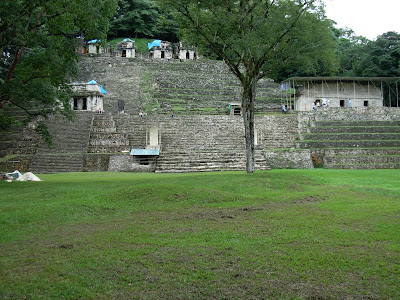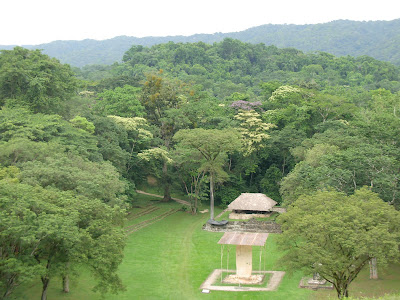

October 27
11 a.m. We got up to a wonderful sound of rain. But everything was damp. After packing and breakfast (Virginia skipped it), and money exchange (12.43), and water, we went deep into the jungle. The area is reserved for Lacandon people, a poverty-stricken people who have been at war with the Mexican empire since its creation. We ate along the road, coconut at one stop, pineapple at a second stop. Lots of speed bumps. When we got to the ruins the entire area is primitive, few cars, little economy. Bonampak.
- Grandpa

We’ve arrived at the Lancanjá village, and are dazzled by the green variety we can see at a glance. Such shapes and sizes and forms!
- Naomi
We packed in heavy rain. Virginia was a little queasy in the stomach, we are not sure what it was from, the rest of us ate well. Then we drove deep into the jungle of Bonampak and the ruins there. The road was paved fairly well, most of the way with a generous number of topes that reduced us to 5mph.. At one speed bump we were going slowly enough to buy cups of fresh coconut with or without chile, we got both. We also got a bag of castaño, or, as we thought earlier, estano, a baked or boiled fruit from a palm tree. Edwin first identified it as a date but since dates grow only in low relative humidity I rejected that guess. Later we found it does grow on palm trees exactly as dates grow. At another speed bump we bought cups of pineapple w or w/o pepper. It was ripe and sweet and we didn't get enough. There were vendors at each tope. At some topes they pulled a rope up across the road to stop the traffic completely.
The Bonampak ruins were like all the rest; they had fallen into disuse about 800 to 900 AD after a brief flourish of extensive building. Most of the buildings featured some individual and his family and success in taking prisoners.

In the evening the kids ate native food in the restaurant, I ate avocados. The Lacadone are tiny people, less than 4 feet high and about 80 to 120 lbs, in general. They speak Spanish as a second language only to accommodate tourists and income.
We spent the night in shacks made of walls with gaps half to an inch wide between each vertical round pole an inch or two in diameter. A lizard or small snake could easily have passed through the walls but we didn't worry. The door was covered by a draping cloth that came to within six inches of the floor so the pumas or larger carnivores could easily have come through the door to eat them. The bunk beds were standard and in good shape considering the humidity, the roof was excellent, the floor was standard wooden floor of unknown species of wood as the jungle supplied a variety. The vendor said that when a tree falls or dies they bring in a mobile saw and cut it into useable pieces. The best thing of the shacks were the mosquito nets. They were heavy duty and very good, falling generously to the floor with enough weight to not move around. Funny thing, we had no mosquitoes, maybe just the time of year.
The shacks were along a nice river, lots of water and sound. The bath room was as modern as a roofless house can be but they had plenty of hot water. It was a communal house and when we were there some tourists on a bus shared it with us. The night was the darkest I have ever seen, absolutely black, as dark as possible, I would have gotten lost if it were not for ambient lights from other shacks and the bath house since I seldom use a flashlight. Edwin took a shower later than the rest and saw a 'black on yaller' snake in the bathhouse so Naomi came by to tell us all to not go for walks, a lot of good it did, it was too dark to go anywhere and all the kids were asleep and didn't hear.
It was cold that night, they supplied a blanket and I used it.
- Grandpa

 Landing strip at Bonampak
Landing strip at BonampakThe Bonampak ruins were unusual in that we could not take our private vehicle to the ruin site, deep in the jungle; we had to pay passage in a hired van, which would drive us about half an hour on a good dirt road, and then return us. Imagine our surprise when we saw that the van we rode in was a twin to our own car! This 15-passenger Ford super van was a 1998, while ours is a ’97. It was red, while ours is white. But other than that, it was a very familiar place to be. Edwin noticed that the clock was wrong, so he taught the owner/operator how to set it. We learned that he recently bought the car, with over 300,000 miles on it, for $10,000. We paid less than that, with less than 100,000 miles on it. It’s a wonder they can make a living, with that kind of expense up front.
The Bonampak ruins featured the most colorful murals extant in any ruin. However, the literature said that the murals have faded substantially since first discovered several decades ago. We were prohibited from photographing the ruins, as flashes accelerate the fading. The Internet said the ruins were discovered by a pilot flying over. But our guide gave a more colorful account, involving a canoe trip through the river, and someone falling overboard and drowning.
We spent a delightful night in the jungle. Unfortunately, we were enjoying it so much we didn’t write about it, and even worse, we didn’t photograph it. In fact, I just spent a lot of time googling Lacanja village trying to find pictures of the very rustic huts in which we stayed, to no avail. You’ll just have to go and experience it yourself. There is a picture of the outskirts of the camp. At least I think it’s the same Lacondon village. (http://images.google.com/imgres?imgurl=http://image61.webshots.com/61/0/59/54/393205954hApwMy_fs.jpg&imgrefurl=http://travel.webshots.com/photo/1393205954049221485hApwMy&usg=__rYI1NAg5PoNwcVcFKsxp8wHvFV4=&h=1704&w=2272&sz=778&hl=en&start=1&um=1&tbnid=SDbpjpsGzz70kM:&tbnh=112&tbnw=150&prev=/images%3Fq%3Dlacanja%2Bvillage%26um%3D1%26hl%3Den%26client%3Dfirefox-a%26rls%3Dorg.mozilla:en-US:official%26sa%3DG) but nothing of the huts in the real jungle.
- Naomi
No comments:
Post a Comment